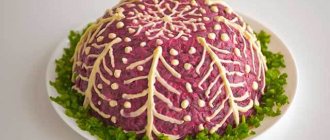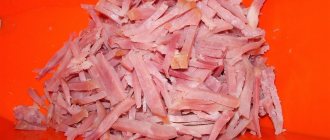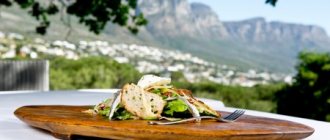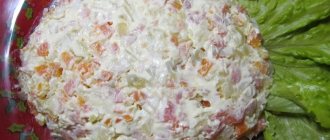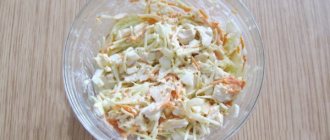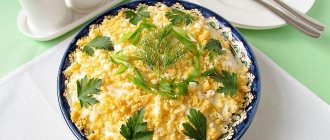7
Prepared by: Marina Shcherbakova
12/29/2016 Cooking time: 3 hours 0 minutes
| Save | I cooked) | Estimate |
Many people have probably wondered what everyone’s favorite “Olivier” should be like according to the classic recipe of Lucien Olivier. I suggest you try making an original salad with crayfish tails!
History and first recipe
The authentic Olivier salad was invented back in the 60s of the 19th century.
The authorship belongs to a Russian of French origin, Lucien Olivier, who was the chef and part-time owner of the Hermitage restaurant. This establishment was one of the most prestigious and popular in Moscow, so Lucien’s task was to come up with an unusual dish that met the needs of gourmets from high society. Very refined and unusual ingredients for our time were chosen for the dish. The main element was boiled fillet of hazel grouse or partridge. Shredded meat and cubes of chicken broth were placed alternately on the lettuce leaves. Next they added boiled crayfish necks and pieces of veal tongue. This goodness was topped with a signature mayonnaise sauce, and the center of the plate was decorated with boiled potatoes, pickled gherkins and slices of boiled eggs.
According to Lucien's idea, the “slide” in the middle served as decoration. However, very soon the man noticed that customers liked to mix the designer delicacy into a pile. At first, this angered the chef, but then he reconciled himself and began to mix everything himself, seasoning the ingredients with mayonnaise sauce. It was in this form that the salad, which was named after the chef, quickly gained popularity among Muscovites and became a distinctive feature of the restaurant.
The highlight of the dish was the signature mayonnaise, which was prepared by the chef himself according to a special recipe. Many chefs tried to find out its ingredients, but they never managed to unravel Olivier’s secret. Therefore, a salad with an original taste could only be tasted in the Hermitage.
Presumably, Lucien prepared mayonnaise from French wine vinegar, mustard and Provençal olive oil, and at the end added some herbs, but no one knew the exact method of preparation.
The famous chef, for some reason, did not write down his recipes, as other chefs of the era did; Consequently, the recipe died with its author, so we cannot know the exact original form. Various historical records indicate that Olivier included products such as capers, caviar, smoked duck, soybeans and truffles. This does not necessarily mean that all these versions are incorrect.
Perhaps the cook used different products depending on the season or the requirements of fasting (for example, the Orthodox Church forbade the consumption of certain foods during Lent).
Olivier: the story of a culinary masterpiece
As you know, if you eat only sausage, you soon get bored with it, and you want to try something new. The same principle worked here: people were tired of this spicy monotony, and there were fewer and fewer customers in the restaurant. It was thanks to this that Lucien thought about a new interesting dish that would attract customers. During culinary experiments, he came up with a new recipe, now known to everyone as Olivier salad. The history of the origin of this dish is so interesting that you just can’t wait to try it. But it is known that today’s salads are radically different from the one that was created in the beginning. It was refined and something unusual, something that restored the popularity of the Hermitage, and its owner the glory of a great chef. Fans of this dish gave it the name Olivier. The story doesn't end there.
Secrets of the legendary Olivier salad
According to lovers of secrets and mysteries, the famous author of the legendary salad, culinary specialist Lucien Olivier, whose grave is located in the former German, and now Vvedenskoye, Moscow cemetery, took away the original recipe for his culinary masterpiece.
During his lifetime, the famous Moscow culinary specialist Lucien Olivier, owner of the Hermitage restaurant, called his signature salad “Game Mayonnaise.” It was with the light hand of Moscow gourmets that the now popular salad was given the name of its creator, which stuck with it along with the wide distribution of this very spicy dish in Russian cuisine, which became one of the main attributes of the New Year's table not only in Russia, but also for compatriots far beyond its borders. outside
Monsieur Lucien Olivier
Before you give laurels to the creator of the salad, you should find out who he was. It is interesting that the life of a talented chef will explain to us why this culinary masterpiece is so popular among the Russian people, and we will know the real history of the Olivier salad. The creator of this dish was named Lucien Olivier, he was a Frenchman capable of culinary art. He was born in 1838. He had two more older brothers, who cooked no less tasty. But they chose to stay in their homeland. In his youth, Lucien went to Moscow in order to earn extra money. He chose this country because he knew that Russian people were interested in French cuisine. This is where the history of Olivier salad began. It is worth immediately noting that an improved recipe for Provencal mayonnaise was born in this family, which Lucien used in his kitchen. Olivier began his business by opening his own restaurant, “Hermitage,” which initially enjoyed enormous success.
Recipe
The earliest known publication of the recipe is given in the magazine “Our Food” No. 6 dated March 31, 1894: fried hazel grouse, potatoes, fresh cucumbers, capers, olives, Provencal sauce with the addition of Soy-Kabul soy sauce. Recipe from a 1913 book by cook D.I. Bobrinsky: game meat or chicken, potatoes, pickles (pickled vegetables), eggs, lettuce, mayonnaise and soy-kabul.
Olivier from “The Book of Tasty and Healthy Food” (1948): boiled or fried hazel grouse meat, potatoes, fresh or pickled cucumbers, eggs, green salad, mayonnaise, soybeans, vinegar or lemon juice, powdered sugar. Over time, the recipe has undergone some changes: meat is often replaced with boiled sausage and boiled carrots with canned peas are added.
To decorate the dish, use any desired products. For example, various sources give the following options: crayfish necks, chopped lanspik (frozen meat and bone broth similar to jellied meat), pieces of truffle, lettuce, slices of cucumber, tomato, eggs, pieces of meat.
The first recipes use a variety of soy sauce called Soya-Kabul. In the recipe for Game Salad (1952, 1961), Yuzhny soy sauce is indicated instead; in Meat Salad (1959), it is suggested to use Yuzhny or Moscow soy sauce. All of them are not widely used.
Benefits and harms
Each product included in Olivier has beneficial properties. By consuming it, a person receives plant and animal proteins, vitamins, starch, etc. Since there are different options for preparing a dish, it may contain different substances and elements necessary for the body.
Only mayonnaise, which is used to season everything else, is harmful. It is a heavy product because the body has to spend a lot of time digesting it. This leads to problems with the pancreas.
Caution is also necessary due to the high calorie content of the product - if you consume it frequently, you cannot avoid excess weight.
Olivier salad according to a recipe from the book “Practical Fundamentals of Culinary Art”, 1899
Necessary products and their proportions per person.
- hazel grouse - ½ piece;
- potatoes - 2 pieces;
- cucumbers - 1 piece;
- salad - 3-4 leaves;
- cancer necks - 3 pieces;
- lanspik - ½ cup;
- kaporets - 1 teaspoon;
- olives - 3-5 pieces.
According to the author’s recipe from the book “Practical Fundamentals of Culinary Art,” prepare Olivier salad as follows:
- Cut the fillet of fried good hazel grouse into blankets and mix with blankets of boiled, not crumbly potatoes and slices of fresh cucumbers, add caporets and olives and pour in a large amount of Provencal sauce, with the addition of soy-kabul.
- Once cooled, transfer to a crystal vase and remove with crayfish tails, lettuce leaves and chopped lancepick.
- Serve very cold.
According to the book “Practical Principles of Culinary Art” (1899), fresh cucumbers can be replaced with large gherkins. Instead of hazel grouse, you can take veal, partridge and chicken, but a real Olivier appetizer is always prepared from hazel grouse.
Interpretation of unclear words in Smirnova’s recipe:
- Blanquettes (from the French blanc - clean, white) are straight pieces of food cut into parallel lines, used as semi-finished products for making dishes and culinary products.
- Lanspik is chicken or meat broth boiled to a jelly state.
- Kabul soybean or Kabul sauce is a once popular spicy seasoning brought from Afghanistan.
- Caporets are capers, the pickled or salted flower buds of the prickly caper plant.
How to make homemade mayonnaise?
Making this product at home will require the following ingredients:
- olive oil (or high-quality sunflower oil) – 1 cup;
- egg yolks – 2;
- vinegar (9%) – 1 tsp;
- sugar – 1 tsp;
- salt – 0.5 tsp.
Add salt and sugar to the egg yolks and beat until a homogeneous white mixture is obtained. Continuing whipping, pour in the oil in small portions (in a thin stream). Vinegar is added last and continue to stir the sauce until smooth. It is best to do this with a mixer, but you can use a wooden spatula.
Video recipe:
Olivier recipe from 1905 in Russia
Just a year after the previous masterpiece, Russian chefs have taken their culinary experiments even further. All that remains from the classic recipe in this recipe is mayonnaise and peas with cucumbers.
Where these variations on the theme of the Olivier salad came from in those ancient times, one can only guess. However, the idea of how to make a gourmet snack using this old recipe is quite interesting.
This dish will create special intrigue when we find out what ingredients are needed for this salad ala “Olivier”.
Ingredients
- Potatoes – 150-160 g;
- Kamchatka crabs – 0.1 kg;
- Partridge fillet (can be replaced with chicken) – 0.15 kg;
- Boiled veal tongue – 0.1 kg;
- Pickled cucumbers – 150 g;
- Fresh cucumbers – 60 g;
- Boiled chicken egg – 4 pcs.;
- Canned brain peas – 60 g;
- Capers – 45 g;
- Creamy horseradish – 40 g;
- Mayonnaise – 125 g;
For an original Olivier serving
- Quail eggs – 8 pcs.;
- “Frise” salad – 50 g;
- Red caviar – 20 g;
- Sturgeon caviar – 20 g;
- Crayfish fillet – 80 g;
Preparing the salad
The process does not require any overly original approach.
- Boil the tongue, partridge fillet, crabs, potatoes and eggs until tender. The meat components should be salted. After cooling, chop all the components into equal slices and transfer to a common container.
- We also add peas, chopped pickled and fresh cucumbers, capers and season the salad with mayonnaise and horseradish.
When serving, the dish is decorated with “Frise” salad, on which is laid out a portion of “Olivier” salad, decorated with a scattering of red and black caviar, surrounded by quail eggs, and topped with boiled crayfish meat.
Olivier old in a new way
Everyone's favorite salad can be updated by adding some ingredients. This recipe will appeal to many for its unusual taste, which contains sourness and piquancy.
Ingredients of the dish (4 servings):
- Potatoes – 270 g;
- Smoked meat – 320 g;
- Sour cucumber – 160 g;
- Korean carrots – 260 g;
- Canned peas – 190 g;
- Mayonnaise – 90 ml;
- Salt – 9 g;
- Chicken eggs – 5 pieces.
Cooking process:
- Wash and boil the potato tubers in their skins, after cooling, peel the root vegetables and cut into cubes.
- Hard-boil chicken eggs, cool, remove shells, and chop with an egg slicer.
- Separate smoked meat from bones and skin, chop into pieces.
- Cut the pickled cucumber into cubes.
- Place the peas in a colander and wait until the marinade drains.
- Shorten strips of Korean carrots.
- Combine the ingredients, season with mayonnaise and mix.
Further distribution of the dish
The most successful attempt to steal Olivier's idea was made by one of his chefs, Ivan Ivanov. He watched the preparation and was able to roughly write down what the famous dressing consists of. At the beginning of the 20th century, Ivanov left his job at the Hermitage and got a job at another, less well-known establishment, where he began serving a very similar salad called “Stolichny”. However, gourmets of that time reported that the dressing in it was inferior to the special mayonnaise from the Hermitage. Apparently, Ivanov still missed something.
Later, Ivan shared his recipe with publishers of various newspapers and books, and thus contributed to its spread throughout the country. In 1905, the Hermitage was closed, and the Olivier family left Russia, so now their property could safely be called by its name.
So, in a cookbook of 1894, a recipe was published with the following components:
- half a hazel grouse (grouse);
- potatoes – 2 pcs.;
- small cucumber or large gherkin;
- lettuce – 3-4 leaves;
- 3 large crayfish necks;
- a quarter glass of aspic;
- a small spoon of capers;
- 3–5 olives;
- 1–2 tbsp. Provençal dressing.
During the revolution, many Russians had to leave their homeland, and they scattered around the world, thanks to which they learned about Olivier in other countries.
The secret of the restaurant
Lucien quickly gained popularity. All this became possible thanks to mayonnaise, to which he added mustard in the correct proportions and several spices, which gave the sauce an original spice. Huge demand prompted the chef to open another restaurant on Trubnaya Square. His brothers enjoyed the same success in France and were also able to start their own business.
Peas instead of capers
After the death of Lucien Olivier in 1883, the Hermitage restaurant became the property of the Olivier Partnership. Then for a long time the establishment passed from hand to hand. And the famous recipe went to the rich houses of the capital. Or rather, in their kitchens. But each chef came up with his own Olivier salad.
Nevertheless, almost all of them took as a basis the classic version from the best times of the Hermitage. Restored in 1904, according to the recollections of one of the restaurant regulars, the recipe sounded like this: “Fillet of two boiled hazel grouse, one boiled veal tongue, about 100 grams of pressed black caviar, 200 grams of fresh lettuce, 25 boiled crayfish or one large lobster, 200-250 grams small cucumbers, half a jar of soya kabul (soybean paste), 2 finely chopped fresh cucumbers, 100 grams of capers, 5 finely chopped hard-boiled eggs. Dressing with Provencal sauce: beat 400 grams of olive oil with two fresh egg yolks with the addition of French vinegar and mustard.”
The rise in prices of many products during the First World War and the revolutions of 1917 hit Olivier salad hard. But already in 1924, with the beginning of the NEP era, the delicacies that had disappeared again returned.
Cooks of this period gave us several variations of the famous salad. For example, in one of the central Moscow restaurants, which was visited by senior party workers, Olivier was prepared according to the following recipe: 6 potatoes, 2 onions, 3 medium-sized carrots, 2 pickled cucumbers, 1 apple, 200 grams of boiled meat poultry, 1 glass of green peas, 3 boiled eggs, half a glass of olive mayonnaise, salt and pepper to taste.
The director of the Moscow restaurant, Ivan Mikhailovich Ivanov, corrected this recipe, bringing it closer to the one that made the Frenchman Olivier famous, and called the boludo “Stolichny Salad,” publishing its recipe in the book “On Healthy and Tasty Food,” 1955 edition. Here are the ingredients it consisted of: 60 g of poultry or game, 60 g of potatoes, 40 g of fresh, salted or pickled cucumbers, 10 g of green salad, 10 g of crayfish necks, 45 g of eggs, 15 g of “Yuzhny” sauce, 70 g of mayonnaise , 10 g pickles, 10 olives.
In general, there are a great many variations of the famous “Olivier” in Soviet and post-Soviet spaces. The main principle - chop, season with sauce and mix - remains unchanged. And although the modern version of the salad is called “Russian salad” or “salade a la Russe” all over the world, in our country it is still called “Olivier”.
Yes, hazel grouse have long been replaced by chicken or sausage, instead of crayfish necks, housewives crumble boiled carrots, capers are replaced by green peas, and lettuce leaves are replaced by parsley, soybean paste, veal tongue, pressed black caviar simply disappeared from the composition, and mayonnaise is not used personally prepared, but factory-made... And yet this is our favorite “Olivier”! And we will again put this very New Year's dish in the center of the festive table.
Olivier with sausage and pickles
In continuation of the variety of recipes, I propose to prepare a salad with pickles, namely gherkins. The taste of the dish is unchanged, but if you did not prepare vegetables for the winter in the summer, small cucumbers are always sold in the store.
What you will need:
- sausage – 150 g;
- boiled potatoes – 2-3 pcs.;
- boiled carrots – 1 pc.;
- chicken egg – 2-3 pcs.;
- gherkins – 3-5 pcs.;
- sour cream – 3 tbsp;
- green peas – 3 tbsp;
- salt and pepper - to your taste.
How to cook:
Let's start the cooking process. If you haven’t boiled the potatoes, carrots and eggs in advance, then it’s time to put the food on the fire.
Advice! Be careful when cooking potatoes, carrots and eggs. For example, it is better to add salt to eggs so that they do not burst and leak. And to prevent the potatoes from boiling, keep an eye on them, piercing them periodically with a fork to determine readiness. For myself, sometimes I set an alarm clock on the stove so that there are no distractions and I can clearly keep track of the time. Children can be drawn into the game instantly, you will forget about everything in the world. ))
We start by cutting the sausage into cubes. Make the cubes small, but not small, so that the sausage does not get lost in the salad. Put it in a bowl.
Next, cut the cucumbers into cubes too. It’s better to put them on a napkin first so that all the excess water comes out. Although I like it when the dish turns out juicy, and sometimes, on the contrary, I even add a couple of tablespoons of pea juice or cucumber pickle.
We start cutting the eggs when they have cooled down. To judge eggs faster, throw them into cold water. We also cut into cubes, like other products. It is important that all ingredients are approximately the same size, then it will turn out to be ideal in consistency, appearance and taste.
Cut the potatoes into the same cubes. I honestly don’t like cutting it, because everything sticks to the knife. But I found a way out - first wet the knife in water and my hands too.
Now we cut the carrots, the last ingredient of the classic salad, which requires preparation.
All that remains is to add green peas, sour cream, salt and pepper to taste. By the way, you don’t have to add pepper, but use another sauce instead of sour cream, for example, I often use olive mayonnaise.
Source - https://www.youtube.com/watch?v=Zu3BMpsgW-8
Another Olivier is ready. Let's put it in the refrigerator so that it soaks and acquires an exquisite and unforgettable taste.
An original simple salad with potatoes, pickles and onions is easy to prepare, and the presentation will interest everyone.
Subtleties without which nothing good will work
From the most important point, there should be no sausage or ham in Olivier, only boiled meat. 1. For many, this will seem like a strange habit. Try at least once to make a salad not with sausage, but with boiled, lean pork, and you will never go back to the “station” salad with sausage. 2. Try to cut the ingredients into identical, not large cubes, green peas will be your guide, try to cut the rest not much larger. This often seems like a small thing and many people neglect proper cutting, but believe me, the taste of the dish will greatly depend on the cutting. 3. Always cut onions with a knife and never on a grater - the onion juice released during grating will kill your salad. 4. The number of eggs should match the number of medium potatoes. If you boiled 5 eggs for a salad, then there should be the same number of potatoes: 5. Be sure to add acid before serving - it could be lemon juice, a little vinegar or soy sauce if you like. Not a lot, about a tablespoon of lemon juice per salad bowl or less. 6. Salt and season with mayonnaise only just before serving - if you have prepared more than one salad, store it in the refrigerator unsalted and unseasoned with mayonnaise. 7. Sugar a little, a pinch of sugar is enough for the whole salad bowl 8. Greens, pepper and other seasonings are not necessary for Olivier, although a little black pepper definitely won’t harm the dish, the rest are rather for everyone and have nothing in common with the classic recipe 9. Don’t neglect quality green peas, use only soft pickled peas from the brain varieties. It is recommended to add, in addition to salted ones, 1 fresh cucumber 10. Never use cheap mayonnaise, many often think of saving money on this - a big mistake, high-quality (homemade or purchased) mayonnaise is a very large part of the overall taste. You can put less mayonnaise, but then add vegetable oil for softness and taste. You can have olive and sunflower.
Gourmet dish turns into salad
Lucien tried to make his new dish not only tasty, but also original in appearance. But soon he had to make some adjustments and change its external beauty, and this did not make the salad any less popular. The fact is that the ingredients that were placed in the center of the plate were rather intended for decoration. But Russian people do not have the mentality to leave food untouched. This is precisely what reflected the fact that the history of the origin of Olivier has changed a little. One day, Lucien noticed that his visitors mixed all the ingredients and only then ate them. He realized that for Russian people the appearance of a dish is not as important as its taste, so he interpreted his own recipe. Now the cook cut all the ingredients into slices, poured in a sufficient amount of branded mayonnaise and mixed everything well. The Russian people now have an exquisite and favorite Olivier salad. The French chef took the classic recipe with him without giving away the secret. The great cook passed away in 1883.
Olivier in other countries
Various variations of Olivier can be found in almost any Eastern European country, from Ukraine and Bulgaria to Poland and Hungary. In many countries it is called Russian or potato salad, while others retain the original name. In Croatia and Slovenia, it is customary to prepare vegetarian Olivier, which is called French. The Greek version also does not contain meat.
In Romania, you can find a traditional dish called "salată de boeuf" (beef salad), which includes beef, root vegetables, maritura (traditional Romanian pickles) and a mayonnaise dressing. There is also a purely vegetarian option.
In Spain, many bars often serve the so-called “Little Russian salad”, consisting of almost the same ingredients as the classic Russian “Olivier”, only instead of sausage, the Spaniards add canned tuna. In Italy, “Insalata russa” has the same components. A similar version is popular in Portugal, where it is called "salada russa".
There is also an Asian interpretation of Olivier. The Turkish version consists of boiled carrots and potatoes, pickles, boiled peas and mayonnaise. The whole thing is garnished with boiled, chopped eggs and black olives. In Pakistan and India, the dish is prepared from potatoes, peas, apples/pineapples and mayonnaise sauce.
Due to the immigration of Italians, Spaniards and Europeans, Olivier is also very popular in Mexico, Ecuador, Peru, Argentina, Paraguay, Uruguay, Brazil and the Dominican Republic. “ensalada rusa” contains a minimum of ingredients: boiled potatoes, carrots, asparagus and a rich mayonnaise-based dressing. In Argentina, it is usually served as a first course or with a very thinly sliced beef roll called matambre.
Soviet version
Having looked at the history of the Olivier salad and briefly learned about its origins, many will notice that the modern dish is fundamentally different from the one that was originally served.
This is not surprising, since in the Soviet years people did not have such an abundance of food on their tables that wealthy restaurant owners and nobles could afford. A new version of Olivier has gained popularity among most families, which many still use today. Almost everyone loves him since childhood. Here is its recipe:
- 4 hard-boiled eggs;
- half a kilo of Doctor’s sausage;
- 4 boiled potatoes;
- 4 pickled cucumbers;
- a can of canned peas;
- a pack of Provençal;
- herbs and salt as desired.
All components are finely chopped, mixed and seasoned with the famous sauce. Here, everyone's favorite Soviet-era dish is ready!
Well, the recipe for the classic Olivier in grams and doses
Potatoes 5 medium (boiled) eggs 5 pcs (boiled) carrots 2 pcs (boiled) onions - 1 pc (fresh) pickled cucumber - 4-5 pcs, you can also pickled, but it’s a little different Fresh cucumber - 1 pc will give a taste of freshness green peas - 1 can non-fat meat - 400-600g (boiled) salt, sugar, mayonnaise - to taste, before serving lemon juice - 1 tbsp. before serving I repeat - no sausage/ham, except as a bite; you can serve with lightly salted herring/salmon/trout and sliced pickles.
Sources
- https://qwizz.ru/%D0%BA%D1%82%D0%BE-%D0%BF%D1%80%D0%B8%D0%B4%D1%83%D0%BC%D0%B0% D0%BB-%D1%81%D0%B0%D0%BB%D0%B0%D1%82-%D0%BE%D0%BB%D0%B8%D0%B2%D1%8C%D0%B5/
- https://www.vokrugsada.ru/novogodniye-retsepty/istoriya-olivye/
- https://ru.wikipedia.org/wiki/%D0%9E%D0%BB%D0%B8%D0%B2%D1%8C%D0%B5_ (%D1%81%D0%B0%D0%BB% D0%B0%D1%82)
- https://tvoi-povarenok.ru/istoriya-sozdaniya-salata-olive.html
- https://altai.aif.ru/ny/olive_pridumal_narod_smeshal_istoriya_samogo_novogodnego_salata_rossii
- https://fishki.net/3185758-salat-olivye-istorija-i-sovsem-nemnogo-o-reception.html
[collapse]

